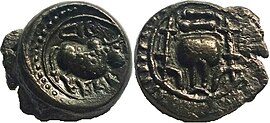Vishnukundina dynasty
This article includes a list of general references, but it lacks sufficient corresponding inline citations. (March 2016) |
Vishnukundina dynasty | |||||||||||
|---|---|---|---|---|---|---|---|---|---|---|---|
| 420–624 | |||||||||||
Vishnukundina Empire, 420–674 AD, cast copper, 4.65g, Vidarbha (Maharashtra), Bull type. | |||||||||||
Classical India | |||||||||||
• Established | 420 | ||||||||||
• Disestablished | 624 | ||||||||||
| |||||||||||
The Vishnukundina dynasty (
The area north of the
Origin
"Vishnukundina" is a
During the reign of Madhava Varma, they became independent and conquered coastal
.Chronology
The Vishnukundina reign might be fixed between the end of the
Govinda Varma I
[5] Govinda Varma I took the imperial title of Maharaja and his son Madhava Varma I was the founder of the power based on grants from Sriparvata (Nagarjunakonda) and Indrapalagutta.[6]
Madhava Varma I

The reign of Madhava Varma (c. 420 – c. 455). He was the founder of the Vishnukundina power.
Madhava Varma II
Madhava Varma II was the most powerful ruler of Vishnukundina dynasty. The reign of Madhava Varma II (c. 440 – c. 460) was a golden age in the history of the Vishnukundinas. The Vishnukundina dynasty reached its greatest territorial extent under Madhava Varma II. He defeated Prithvishena II, the powerful ruler of Vakataka dynasty. Vakataka Mahadevi, the daughter of Prithvishena II, was given in marriage to him.
By the middle of the 5th century, the dynasty rose to imperial heights. A princess of the then powerful ruling family of the
This alliance enabled them to extend their influence to the east coast and vanquish the petty chieftains lingering on in that area. Madhava Varma II led his arms against
After occupying these areas from the Ananda Gotrikas, Madhava Varma II made Amarapura (modern

Madhava Varma II next turned his attention against the
Successors of Madhava Varma II
The fortunes of the Vishnukundinas were at a low point during the reign of the next ruler Vikramendra Varma I (508–528). The next two and half decades also experienced the constant strife and dynastic struggles during the reign of Indra Bhattaraka Varma (528–555). Though Indra Bhattaraka could not withstand the hostile Kalinga subordinate, Indra Varma and lost his life in battle. The Vishnukundinas lost their Kalinga possessions north of the Godavari.
Vikramendra Varma II
With the accession of Vikramendra Varma II (555–569), the fortunes of the Vishnukundina family were restored. To have immediate access to the Kalinga region, he shifted his capital from Bezwada to Lenduluru (modem
Janassraya Madhava Varma IV
The Vishnukundina empire set about again to imperial expansion and cultural prosperity under its able ruler Janassraya Madhava Varma IV (573–621). This prudent king spent his early years of rule in consolidating his position in Vengi. The later part of his reign is marked by wars and annexations. In his 37th regnal year, he suppressed the revolt of his subordinate chief the Durjaya Pruthvi Maharaja in Guddadivishya (modern
Madhava Varma IV had to face the

Vishnukundina country
They had three important cities, Indrapalanagara,
Administration
For administrative convenience, the empire was divided into a number of Rashtras and Vishayas. Inscriptions refer to Palki Rashtra, Karma Rashtra, Guddadi Vishaya, etc.[citation needed]
Madhava Varma III appointed members of the royal family as Viceroys for various areas of the kingdom.
The king was the highest court of appeal in the administrator of justice. The Vishnukundina rulers established various kinds of punishments for various crimes. They were known for their impartial judgment and high sense of justice.
Army
Their army consisted of traditional fourfold divisions:
- Elephants
- Chariots
- Cavalry
- Infantry
The Hastikosa was the officer-in-charge of elephant forces and the Virakosa was the officer-in-charge of land forces. These officers also issued grants on behalf of their monarchs.
Taxes

There may have been well-organized administrative machinery for the collection of land revenue.[citation needed] Agrahara villages enjoyed tax exemptions. Sixteen types of coins of the Vishnukundina rulers have been found by archaeologists.
Religion
All the records of the Vishnukundinas and the kings prior to the Madhava Varma II seem to be patrons of Hinduism.
From the time of the accession of Madhava Varma II, an aggressive self-assertion[
The names of rulers like Madhava Varma and Govinda Varma show their
Literature

The Vishnukundinas were also great patrons of learning. They established colleges for Vedic learning. Learned Brahmins were encouraged by gifts of lands and colleges were established for the propagation of Vedic studies. Indra Bhattaraka established many schools for imparting education on Vedic literature. The performance of several elaborate Vedic ceremonies by Madhava Varma is evidence of the faith of the rulers in Vedic Hinduism and the popularity of Vedic learning with the people during this period.
Some of the Vishnukundina kings were credited with authorship of several books. Vikramendra Varma I was described as Mahakavi – a great poet in a record. Further, an incomplete work on Sanskrit poetics called 'Janasraya Chando Vichiti' was attributed to Madhava Varma IV who bore the title of 'Janasraya'. Sanskrit enjoyed royal patronage.
Art and Architecture
Being great devotees of
See also
| Part of a series on |
| Andhra Pradesh and Telangana |
|---|
 |
| History and Kingdoms |
| History of South Asia | |
|---|---|
 | |
| (330–323 BC) | |
| Maurya Empire | (321–184 BC) |
| Seleucid India | (312–303 BC) |
| Sangam period | (c. 600 BC – c. 300 AD) |
| Pandya Empire | (c. 300 BC – AD 1345) |
| Chera Kingdom | (c. 300 BC – AD 1102) |
| Chola Empire | (c. 300 BC – AD 1279) |
| Pallava Empire | (c. 250 AD – AD 800) |
| Maha-Megha-Vahana Empire | (c. 250 BC – c. AD 500) |
| Parthian Empire | (247 BC – AD 224) |

